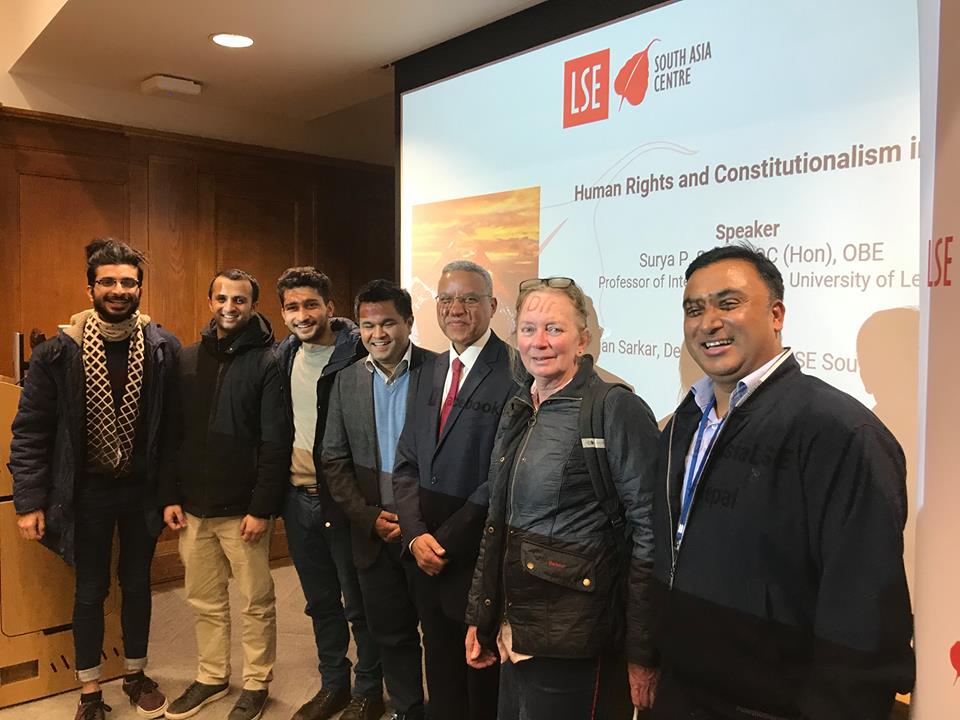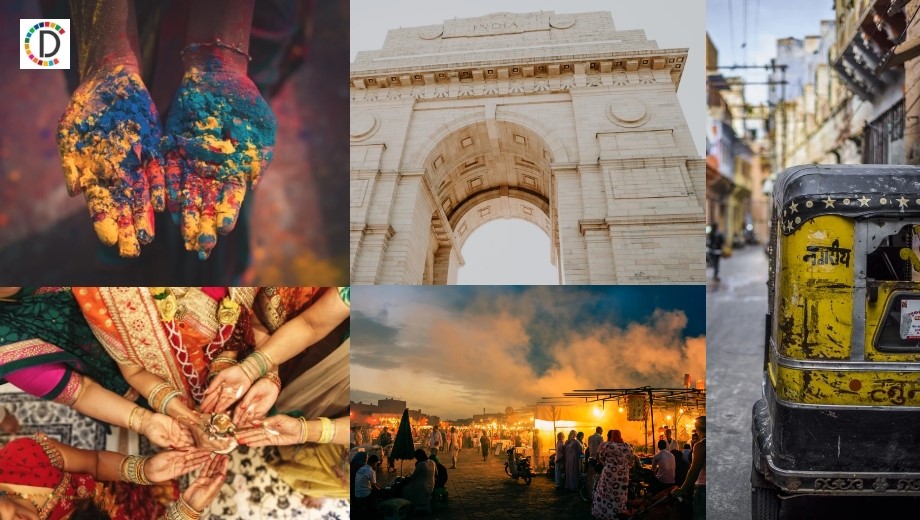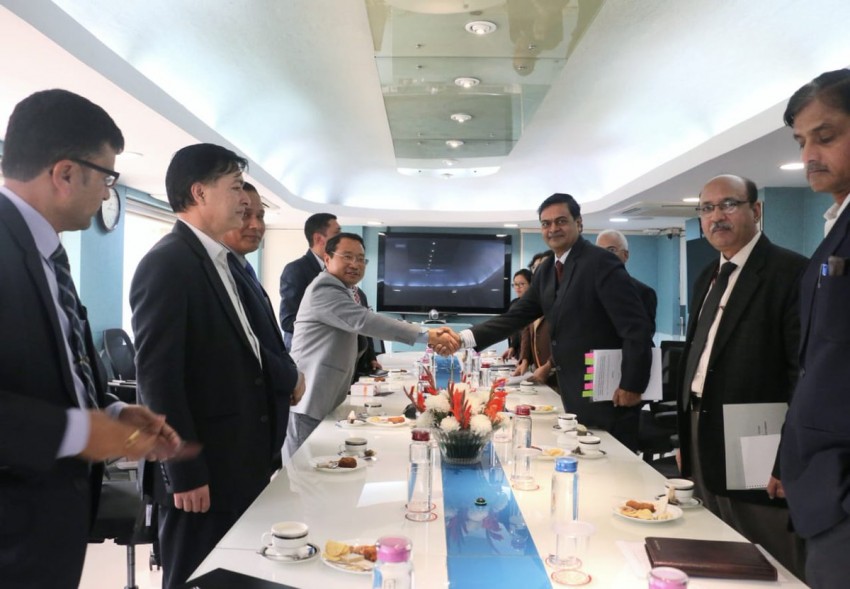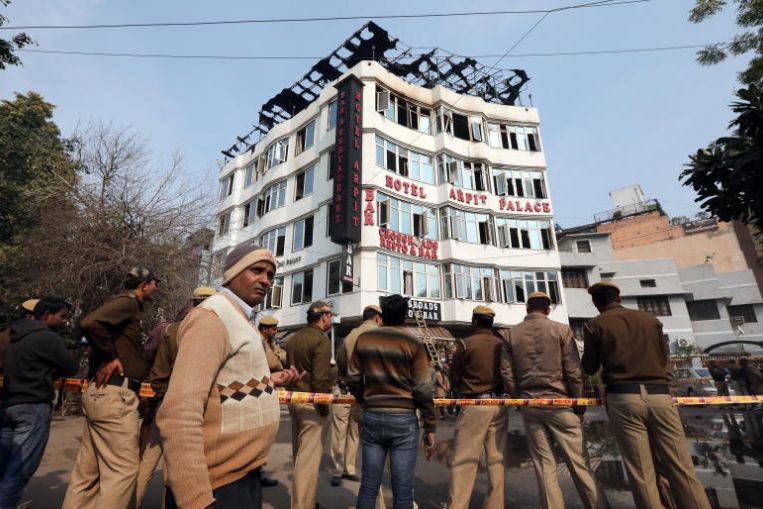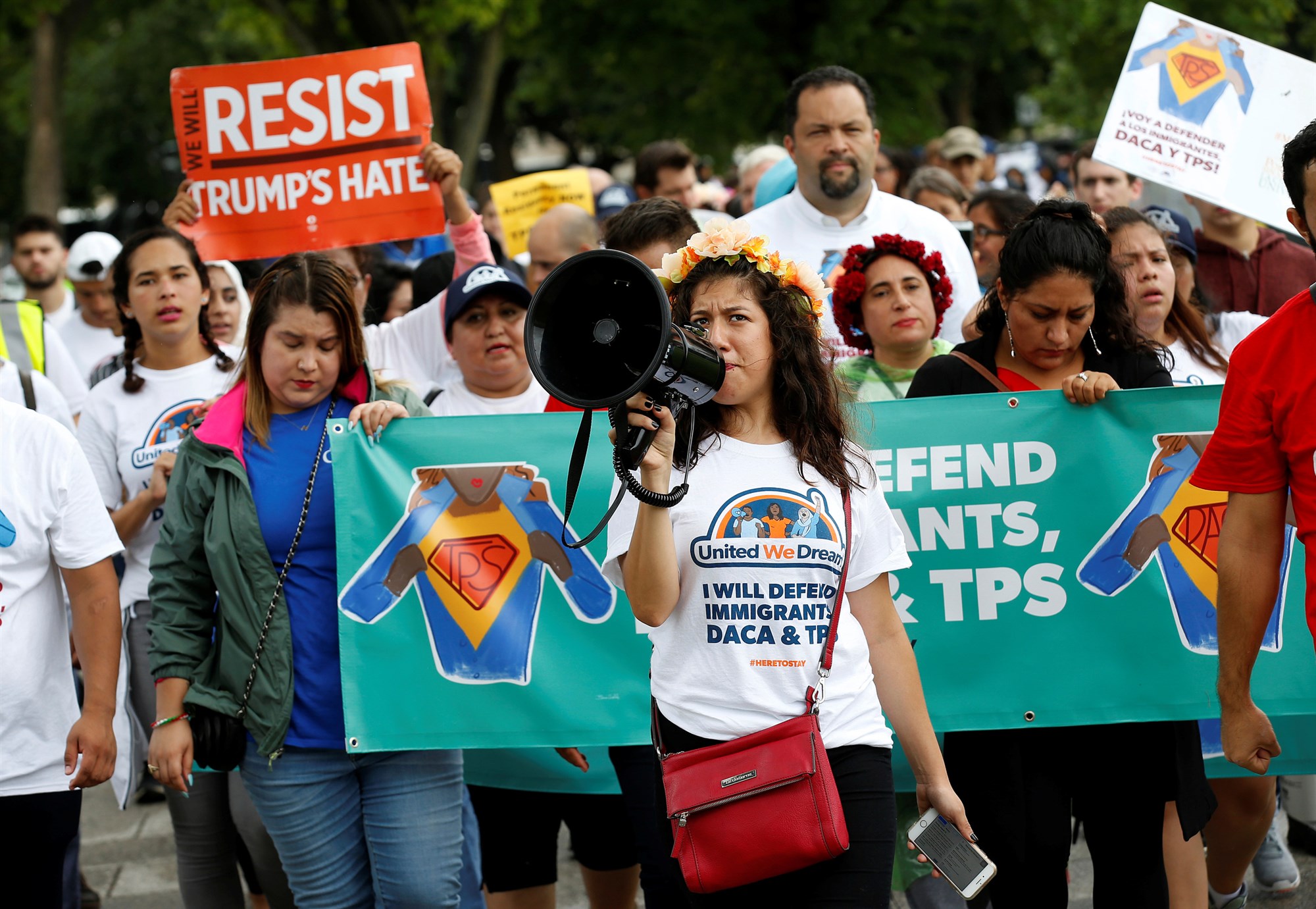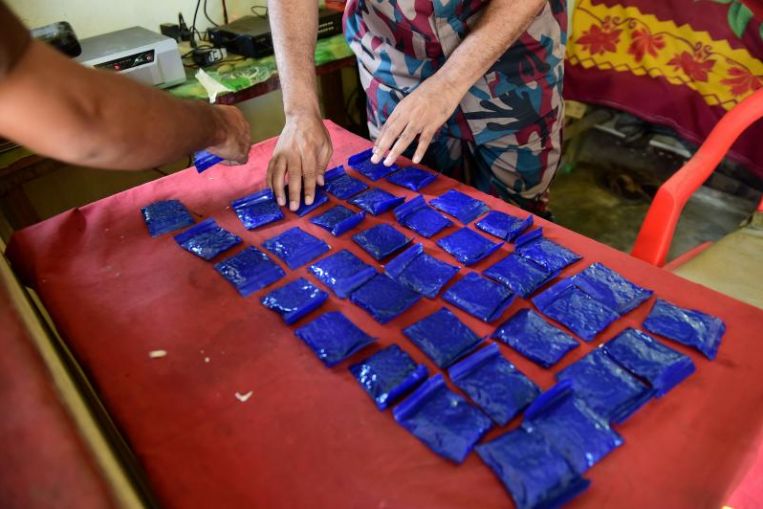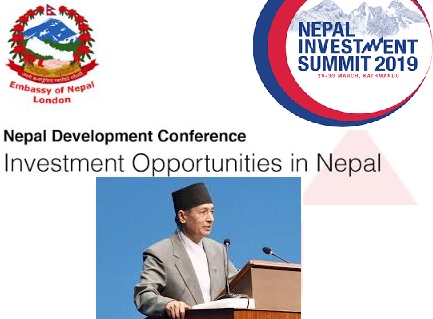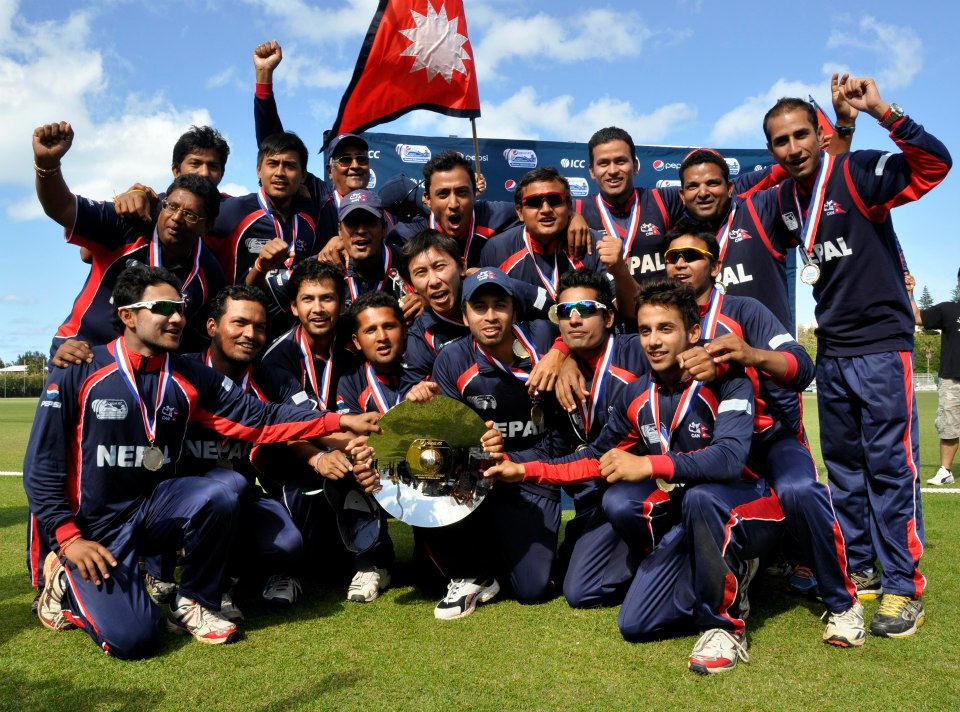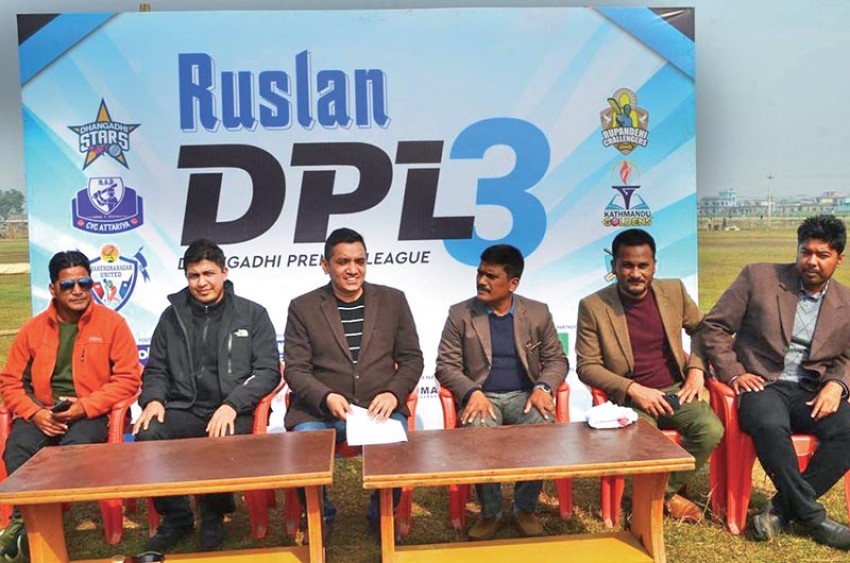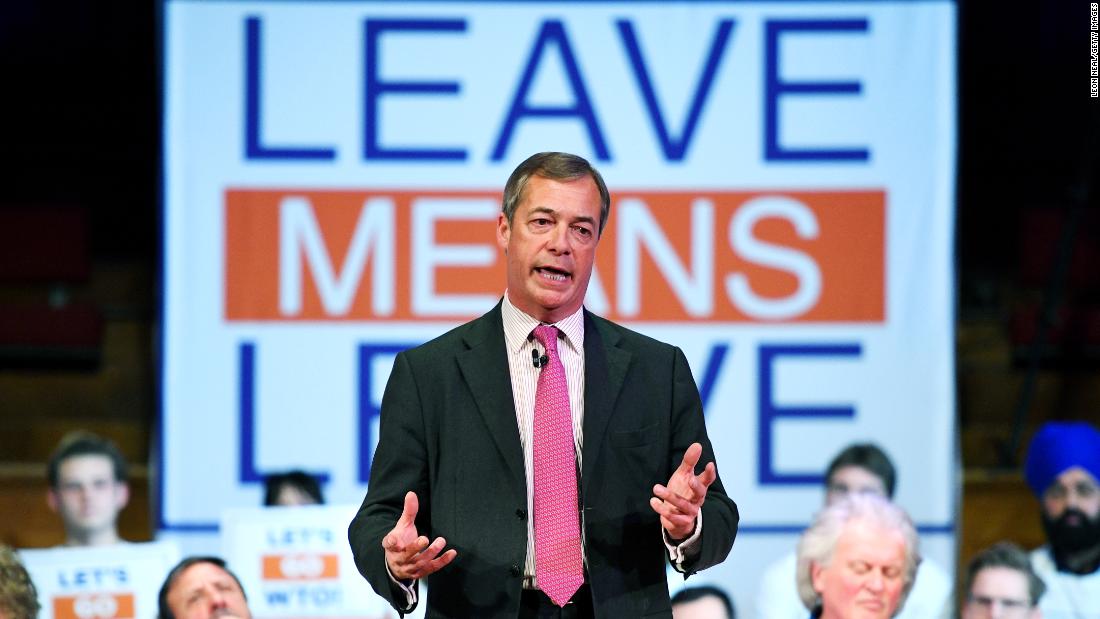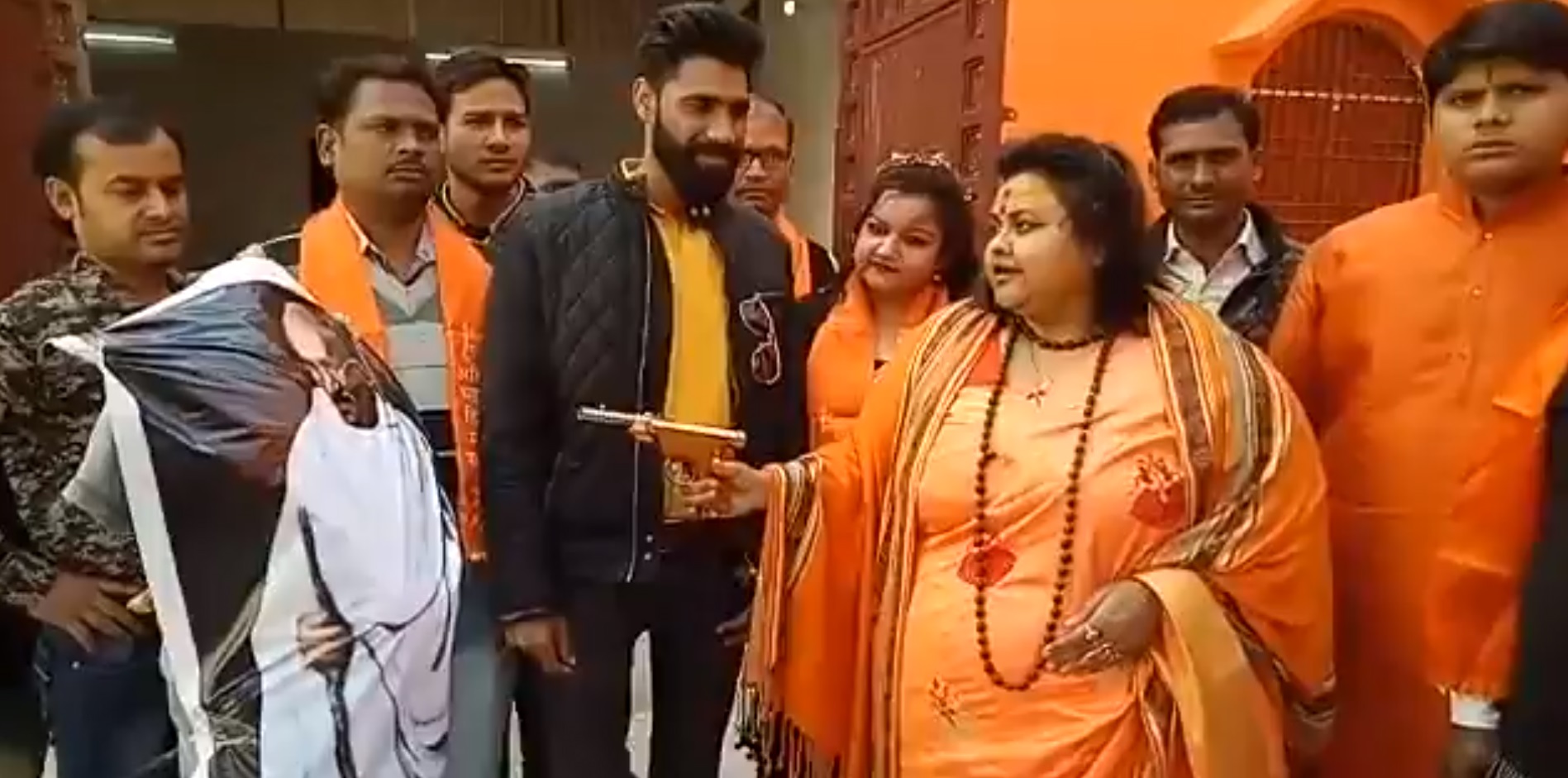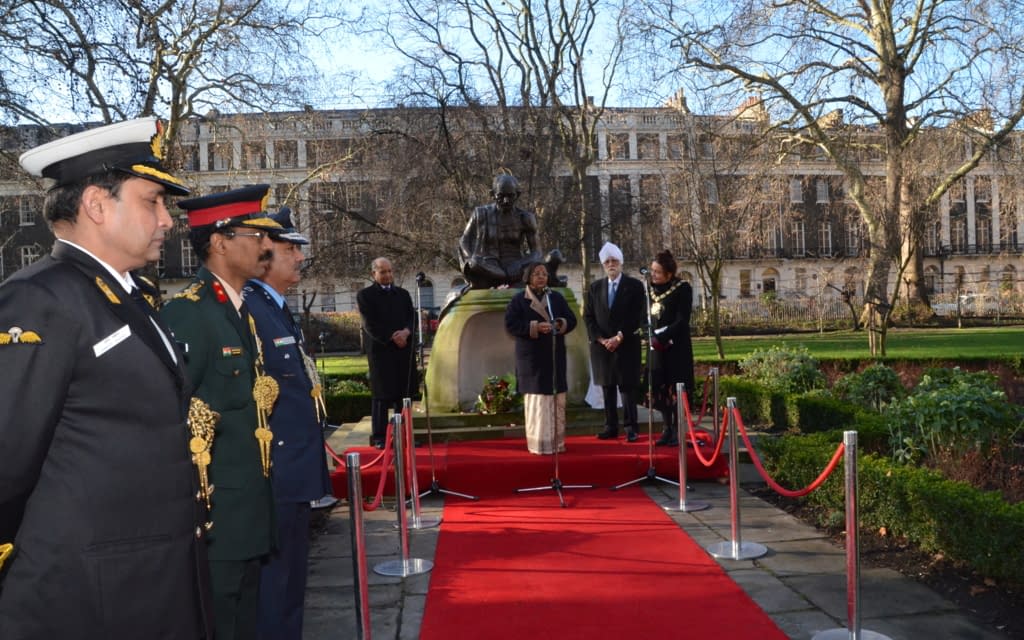London : The South Asian wing of the London School of Economics organized a public lecture program about the issue of human rights and the constitution of Nepal on 13th of February, 2019 at the at the Vera Ansty Room of LSE main building.
Prof. Dr. Surya Subedi, QC(HON), OBE was the key person to deliver the lecture on the program about this subject matter.
Dr. Subedi is the professor of international law at the University of Leeds and renown lawyer in international law who has been feted with many prestigious awards.
The program was chaired by Mr. Nilanjan Sarkar, the Deputy Director of South Asia center LSE.
The title of the program was “Human Rights and Constitutionalism in Nepal”.
Providing a brief about the foundation of the constitutionalism of Nepal through the South Asian influence, the influence of the Hindu religion, diversity and as well as the influence from the international practice, Mr. Subedi stated that the constitution of Nepal is the youngest and progressive constitution of Nepal. S
Dr. Subedi said that the legal system of Nepal is a blend of common law, civil law and Hindu law.
The constitutional documents and policies are really beautiful in Nepal however there is a lack of political will to implement them. The country still lacks a visionary leader with statesmanship to lead the historic change, He stated.
Subedi also pointed out that the country should be ruled by the supremacy of the law however the mindset of the leaders is seen to be autocratic. The impeachment to the CJ Sushila Karki and many acts of political interference to the constitutional bodies are the examples of such mindset, he added.
Notably, Subedi highlighted the nonexistence of leader in Nepal with statesmanship like Gandhi, Ginna, Mandela who handle the new change so well. Nepali leaders fail to manage the transition and still trying to overrule the nation by evading the constitutional supremacy.
If the political transition was well managed during 1990, perhaps the 10 years long Maoist insurgency could be avoided, he said. He also added that the model of peace process adopted by Nepal is the best model that all the leaders took ownership and avoided international interference however the transition is still not well managed and the sad part of the political leadership is not to handle the TRC in an appropriate manner.
Many international intellectuals along with the professor Dr Krishna Adikari, Director of the LSE South Asia center Mukulika Banarjee along with many scholars ask questions and curiosity about the constitution of Nepal.
The script of the lecture by Prof. Dr Surya Subedi :
Human Rights and Constitutionalism in Nepal
A Public Lecture delivered at the London School of Economics, University of London
Professor Surya P. Subedi QC, OBE
Professor of International Law
University of Leeds
13 February 2019
I would like to thank Dr Sarkar and his South Asia team for inviting me to share my thoughts
this evening on human rights and constitutionalism in Nepal. I am delighted to be here.
I also thank Dr Sarkar for chairing this talk programme and for his kind words of introduction.
I thank all of you for coming to this lecture when many of you may be expected to be making
plans for Valentine’s day celebrations tomorrow!
Introduction
My presentation is divided into three parts: I will begin by outlining the concept of human
rights in Asian countries like Nepal. Then I will discuss how human rights have been
incorporated into the constitution of Nepal and finally I will examine the challenges that Nepal
is facing in protecting and promoting human rights.
The photo of Mt Everest on the screen behind me represents much of what I am going to say
this evening. Daily at dawn Nepali wake up with the first beams of light of the rising sun
lighting up the Himalayas in a glow of golden colours. When the Nepali people look to the
south they see a vast country – India – with a diverse population of 1.4 billion, and when they
look to the north they see another vast country – China – with a diverse population of 1.4 billion.
Thus, the psyche of the Nepali people is influenced by the values of secularism with regard to
the conduct of the domestic affairs of the State, by the values of universalism with regards to
the approach to the outside world, and by the values of adherence to the principles of non-
alignment and peaceful co-existence with regard to the dealings with foreign powers of
2
different faiths and beliefs. It is this universalist approach to life that has influenced the making
of the legal and constitutional system in Nepal.
I remember a beautiful song – Himashrinkhala Ma – composed by Chadani Shah, sung by the
legendary Tara Devi to music by Natikaji. It says that the glow of the rising sun puts a light
touch of laali (a makeup) on to the face of the Himalayas, making them all the more beautiful
in the morning and lifting the fog from the mountains to enable her – the rising sun – to reveal
the beauty of the Himalayas to the world!
I used to get mesmerised by these views during my childhood in Nepal, they would lift my
spirits for the whole day!
It is this beautiful country that we take a closer look at today, in particular the development of
human rights in the country.
We should also be clear from the outset that we are talking about human rights in the modern
sense of the term, the human rights developed mainly after the establishment of the United
Nations and within the framework of Western political thought.
There were elements of human rights and good governance inbuilt in other civilisations too,
but they were not developed in Asia, Africa and Latin America when these countries came
under colonial subjugation and under colonial rule the chances of human rights being
developed diminished. The Buddhist, Hindu and Islamic traditions have their own elements of
human rights built-in in the religious scriptures.
But when these countries gained independence from their colonial rulers they embraced
Western concepts of democracy and human rights. For instance, unlike America, an offshoot
of Britain, India had its own Eastern ancient and rich religious, political and cultural heritage
and it could have turned to its own heritage to develop its own, distinctive system of governance
upon independence. But it did not do so.
Although Mahatma Gandhi led the Indian independence against the British relying on the
principle of non-violence drawn from the Hindu and Buddhist religious teachings, when it
came to establish a system of government for independent India he, along with Pandit Nehru,
adopted the Western style democracy and a British system of government. This is one reason
why critics of Nehru and of other people at the highest echelon of post-independent India have
said that the British left India by handing over power to their own Indian proteges.
3
Historians will tell us why Gandhi and Nehru did not think of developing a system of
governance for India based on Eastern values or Hindu or Buddhist values. After all, India had
a system of government prior to the colonial period.
Going even further back in history, India had quite elaborate scriptures concerning statecraft
such as Kautilya’s Arthasastra or even the Mahabharata which contains the teachings of not
only Lord Krishna but also those of the great warrior and statesman Bhismapitamaha, a highly
revered elder guardian of both the Kauravas and Pandavas, who faced each other in the
battlefield of Kuruchhetra in this epic war. After the war of Mahabharata was over,
Bhismapitamaha imparted important wisdom of governance and statecraft to the victorious
Pandavas while addressing Yudhisthira.
Of course, the elements on human rights integral to the ancient Hindu scriptures like
Mahabharata or Kautilya’s Arthasastra would not have been enough to build a fully functional
system of governance suitable for 20th century India. For instance, the Hindu polity was not
developed enough to cover all aspects of modern governance such as holding elections to
positions of power. However, there was a strong base upon which to build and improve a
system of government founded on Eastern philosophy.
Hinduism is based on a concept known as dharma which defines the relationship between one
individual and another, also between the state and the individual. The essence of dharma is the
distinction between good, supporting the cosmic order, and evil, which poses a threat to this
order. It means ‘duty’, ‘virtue’, ‘morality’, ‘responsibility’, even ‘religion’ and it refers to the
power which upholds the universe and society. Acting virtuously means different people have
different obligations and duties according to their age, gender, and social position. You, as a
ruler, have a duty to look after the interests of the people. You, as the father, have a duty
towards your children and you, as a husband and wife, have a duty towards each other.
The idea is that when everyone follows their dharma then the rights of others are protected.
Thus, the dharmic approach to human rights means that everyone follows their duty so that
others can enjoy their rights. You have a duty of different kinds towards all other members in
society who are related to you in some form and a right to require others to fulfil their duties
towards you.
While the modern concept of human rights requires the state or those who exercise public
authority to protect your rights as an individual, the Hindu concept of dharma does the same
4
by requiring the king or the state and all other members in society to do the same towards you.
Each person therefore has his or her own dharma or duty known as swa-dharma. Some duties
are common to all, but when it comes to specific duties what is correct for a woman according
to dharma might not be correct for a man or what is correct for an adult might not be so for a
child and so on. Thus, in Hinduism you do not have a right but have your dharma or your duty
or your responsibility towards others.
Although the vernacular version of Hinduism in the middle age was ridden with inequality
based on gender and caste systems, there were elements of good governance in Hindu
philosophy. Articulating the qualities needed in the ruler, the king, a celebrated thinker and
writer in ancient Hindu pantheon, Kautilya, states: ‘In the happiness of his subjects lies the
king’s happiness; in their welfare his welfare. He shall not consider as good only that which
pleases him but treat as beneficial to him whatever pleases his subjects.’
There have been instances in Hindu civilisation where the heir to the throne has been denied
the crown for lacking in qualities needed in a king as a benevolent ruler. An earlier or more
ancient version of Hinduism known as the Vedanta Darshan (i.e. the Vedanta philosophy) had
no elements of discrimination based on gender or caste. According to this philosophy, the soul
in every human being is the same; therefore, all human beings should be treated the same.
The Vedanta Philosophy advocated equality among all human beings. For example, please
allow me to quote a Vedic verse which reads as follows: vidya-vinaya-sampanne brahmane
gavi hastini suni caiva swa-pake ca panditah sama-darsinah. Essentially, what is says is that
an enlightened person does not and should not make any distinction between people of any
casts, creed, gender, and colour. Another example is ‘Vasudaiva kutumbakam’ which translates
into “the World is one family”. One more, aatmavat sarbabhuteshu ya pasyati sa panditah.
which says, the one who sees everyone in himself and himself in everyone will be called an
enlightened or learned person.
But latter-day corruption of the Hindu religious scriptures divided the society into different
castes, creating an unequal society and relegating the people belonging to lower classes to an
unequal status. Dissatisfied, disenchanted and disillusioned by these discriminatory practices
in Hinduism and concerned by the misery suffered by other people, a Nepalese Hindu prince,
Siddhartha Gautam, decided to rebel and embarked upon a quest for an idea, belief and social
yardstick for bringing harmony, peace, equality and happiness among all human beings.
5
He meditated for a long time, achieved Nirvana, preached universal values based on non-
violence, inner peace, and equality of all human beings and came to be known as Gautam
Buddha, the learned and enlightened. He was the first Mahatma of the first rate.
Although he was a religious rebel of the time and largely an atheist, he did not discard Hinduism
in its entirety, but sought to reform it by propounding new values and ideas that advocate
egalitarianism and tolerance. His teachings revolved around the following five virtues of human
life: compassion, charity, generosity, purity and truthfulness. No wonder that the masses of
people across Asia who had been relegated to an inferior category by the Brahministic version
of Hinduism were attracted to the egalitarian values of Buddhism, which offered people a
perfect antidote to the discriminatory practices in Hinduism. The protection of personal dignity
is at the core of the modern-day notion of egalitarianism and human rights. The innate rights
of every human being to have their personal dignity protected and respected has enabled human
rights to become popular in the contemporary world.
Perhaps for Gandhi the challenge, or the priority, was to be rid of the British on the one hand,
and to hold India together on the other, since the tension was already high between the Muslim
and Hindu populations of India during the struggle for freedom. This challenge may have been
given priority over the development of a political system based on Eastern values. Gandhi must
have known that if he tried to develop a system of governance for India along Hindu ideals he
would antagonise or alienate the Muslim population.
Hence, the most reasonable policy for Ghandi to pursue was to accept the system of government
of their colonial ruler. After all, both Gandhi and Nehru had been educated in law in Britain
and had come to accept the virtues of the British system of democratic governance. At that
place in time, it seemed more beneficial to adapt an already established system of Western
democracy rather than pursue the creation of a different, new system of governance informed
by Eastern values.
However, in spite of the attempts by Gandhi to hold India together, the country divided along
religious lines in the immediate aftermath of independence, and both, the Hindu as well as the
Islamic States that emerged from the partition ended up embracing not only Western
democracy but also the British system of parliamentary democracy.
It is also possible that Gandhi saw in Western democracy the tenets of Hinduism and Hindu
ideas of good governance and thus had no difficulty in embracing a more advanced Western
6
system of democratic governance. After all, many of the principles that lay behind the
Universal Declaration of Human Rights of 1948 can be found in Hinduism.
After reading law in England and practising it in South Africa, Ghandi must have come to the
conclusion that the Western system of democratic governance would be best suited for post-
independence India with so much diversity. Furthermore, the British had built and operated
crucial institutions of liberal democracy in India, including courts, and the professional
administrative apparatus and the rules associated with them. So, the decision to build on those
already existing structures for courts, professional administration and the law governing them,
would have been seen as very pragmatic.
Even when Mohamed Ali Jinnah established the new State of Pakistan on the strength of Islam,
he decided to embrace the British system of governance rather than seeking to found a new
system based on Islamic values. He was a liberal Muslim. For instance, he stated in his speech
to the first constituent Assembly of Pakistan on 11 September 1947:
“You are free, you are free to go to your temples, you are free to go to your mosques or
to any other place of worship in this state of Pakistan. You may belong to any religion
or caste or creed-that has nothing to do with the business of the state. We are starting
with this fundamental principle that we are all citizens and equal citizens of one State.
Now I think we should keep that in front of us as our ideal and you will find that in
course of time Hindus will cease to be Hindus and Muslims would cease to be Muslims,
not in [a] religious sense, because that is the personal faith of each individual, but in the
political sense of the State.”
How beautiful this speech is! He too must have thought the same way as Gandhi and Nehru
did when adopting Western models of democracy and human rights. Thus, not only for India
and Pakistan but also for most of the colonies which gained independence from the British it
was “down with British imperialism, but long live the values of the British Empire!”
The reason why I have narrated the past here today is that Nepal, surrounded by India to the
east, west and the south, was influenced heavily by the developments in India around the time
of independence of India. Nepal, despite being the country where Buddha was born and despite
being the country which was a Hindu Kingdom for much of its modern history, Nepal did not
consider developing its own system of governance based on either Hindu or Buddhist tenets.
This is because it was ruled for a long time by an oligarchical Rana family or the long line of
the kings of the Shah dynasty, who lacked the vision and foresight needed to do so. Thus, when
7
we are talking about human rights in Nepal, we are talking about human rights in the modern
sense of the term, the set of universal human rights defined by and promoted by the UN.
The Constitutional history of Nepal
The Nepalese legal system is a blend of common law, civil law and Hindu law. This blend
exists today for various historical reasons. Nepal is an ancient State that has existed in various
forms for more than 2,500 years. When the colonial flag flew over the rest of South Asia, Nepal
managed to maintain its independence which was formally recognised by the British through
the 1923 peace and friendship treaty.
Until modern times, Nepal had been governed on the basis of royal edicts based on tenets of
Hinduism and ancient religious codes such as Manusmriti and Kautilya’s Arthasastra, which
sought to regulate both the affairs of statecraft and relations between individuals. As Nepal was
never colonised by any foreign power, there has not been much direct foreign influence on the
legal system of Nepal until recently. Whenever a Nepalese Prime Minister visited foreign
countries, he tried to learn about the legal and judicial systems in the countries he visited,
aiming to introduce elements of foreign civil and criminal law into the Nepalese legal system.
It was way back in 1948 that Nepal promulgated its first constitutional instrument known as
the Government of Nepal Act.
It was promulgated during the last years of the Rana family rule
when Padma Shamsher was Prime Minister. But the Ranas had no sincerity in implementing a
programme of reform. Consequently, there was a people’s movement for democracy which
resulted in the promulgation of the Interim Government of Nepal Act 1951 (known as the
Interim Constitution) by King Tribhuvan. The stated objective was to hold elections for a
constituent assembly to write a new democratic constitution.
But this did not happen, and the Interim Constitution remained in operation until 1959 when a
new Parliamentary Constitution was promulgated by King Mahendra. This democratic
constitution, too, was withdrawn by the King when he took over power from the elected
parliament and the cabinet led by B.P. Koirala. After considering different options, King
Mahendra promulgated a new constitution known as the Panchayat constitution, making him
the executive monarch and placing a ban on political parties.
8
This constitution lasted for nearly 30 years and was repealed when another people’s movement
for democracy in 1990 resulted in the adoption of a new democratic constitution based on a
constitutional monarchy and replacing the executive monarchy, thanks to the foresight and
wisdom of late King Birendra, a gentlemanly king willing to usher the country towards
modernity and democracy.
However, since 1990, Nepal has gone through a great amount of tragedies. Nepal experimented
with liberalism and communism between 1990 and 2014, and finally adopted an ambitious
Constitution in 2015, written by a constituent assembly elected by the people and designed to
usher the country from a Monarchy to a Republic, from a unitary system to a federal structure
and from a first-past-the-post electoral system to a mixed system with elements of proportional
representation.
The new Constitution enshrines a long list of rights, all four generations of rights, i.e., firstly,
the civil and political rights, second, economic, social and cultural rights, third, group rights,
and fourth the right to a clean and healthy environment etc, and the country has ratified most
major international human rights treaties. However, the question that arises is: how democratic
is this Constitution? And is this constitution robust enough to guarantee basic freedoms such
as the freedom of speech?
Constitutionalism in Nepal
The 1990 Constitution was the foundation for the development of constitutionalism and for the
restoration of democratic values and norms. But the people who came to power after the 1990
Constitution could not provide the visionary leadership required to manage the process of
transition from autocracy to democracy. Hence, the country witnessed once again a period of
political instability.
After nearly 10 years of brutal Maoist rebellion, the royal massacre and the third people’s
movement in 2006 against the royal takeover of power by King Gyanendra in 2005, a
comprehensive peace agreement between the Maoists and other political parties was finally
achieved in 2006. Consequently, Nepal has been undergoing a profound socio-economic and
political transformation within an overall framework of democratic polity since 2006.
The monarchy was abolished in 2007 and yet another Interim Constitution was adopted in the
same year. After failing to write a new constitution, the constituent assembly itself was
9
dissolved and new elections took place to elect a new constituent assembly which finally
managed to write a new democratic, federal, and republican constitution in 2015, 9 years after
the peace agreement between the Maoist and the other political parties.
The transformation process and the new Constitution adopted in 2015 firmly establishes the
political, economic, cultural and social rights of the people as the bedrock of Nepal’s
democratic process. The Constitution is the fundamental law and the Supreme Court is the
ultimate power to interpret the Constitution. This limits the arbitrariness of political power and
secures the personal liberty of the people.
By limiting the power of the government, it does not hinder it from working towards good
governance, economic prosperity, inclusivity and lasting peace in the country. It provides for
checks and balances and separation of powers among the three principal organs of the state. It
preserves the independence of the judiciary and makes parliament a powerful institution. It
makes Nepal, formerly a Hindu Kingdom, a secular state, and provides for a federal structure
to accommodate the aspirations of different ethnic groups and a mixed electoral system with
elements of proportional representation to elect people’s representative in as a representative
and inclusive manner as possible.
Human Rights in Nepal
The new Constitution includes a long list of rights of all citizens including the right to
education, health, housing, employment and food sovereignty. It incorporates almost all the
rights set forth in the Universal Declaration of Human Rights and the rights and obligations
enshrined in the human rights treaties to which Nepal is a party, including civil and political
rights, economic, social and cultural rights, and collective rights.
The main focus of the Constitution is on social and ethnic inclusion, constructive recognition
of diversity and attainment of social justice through inclusive, democratic and progressive
restructuring of the state. This is because ethnic, cultural and linguistic diversity is the most
characteristic feature of Nepal as a nation. Ninety-two languages are spoken as mother tongues.
The Nepali language is the official language. Currently, 59 groups are recognized as indigenous
nationalities (Aadivasi Janajati), accounting for 37.2 percent of the population.
A number of economic, social and cultural rights are also inscribed in the Directive Principles
and Sate Policies, which include positive discrimination, reservations and other forms of
10
special support for vulnerable or marginalized groups or communities with regard to education,
health, housing, food sovereignty and employment, for their empowerment, protection and
development.
A range of rights are recognized as absolute and non-derogable, which cannot be suspended
even in emergency. These rights include: the rights to life, equality, personal liberty, justice,
environment, health, education and culture, employment and social security, labour, religion,
rights of the child and women, rights against torture, exploitation, exile, untouchability, racial
discrimination and the right to constitutional remedies and the remedy of habeas corpus. The
Supreme Court has extra-ordinary powers to issue necessary and appropriate writs to enforce
such rights or settle the dispute.
Since Nepal is a party to most international human rights treaties, these treaties have had a
profound impact on the development of human rights in the country. Judges in Nepal have
overwhelmingly used ‘international law’ in developing the country’s human rights
jurisprudence. The Supreme Court in Lawyer’s Association for Human Rights of Nepalese
Indigenous Peoples v Prime Minister and Council of Ministers observed that it is reasonable
to expect the state to comply with and to implement the obligations required by signing a treaty.
In Chandra Kant Gyawali v. HMG Cabinet Secretariat, Janhit Sanrakshan Manch v. Office of
the Council of Ministers and Narayan Bahadur Khadka v Ministry of Home, the Supreme Court
of Nepal acknowledged the supremacy of treaties over domestic laws.
Some scholars have argued that Nepalese courts has employed international law sources to
introduce radical innovations within the Nepalese legal system. This can be observed in a few
court decisions where the entire decision is based upon the premises of international law,
particularly international treaties.
In Sunil Babu Pant & others v. Nepal Government, Office of the Prime Minister and Council
of Ministers & others the Supreme Court of Nepal cited several international instruments. It
even referred to “soft” sources of human rights laws such as the report of the international
commission of Jurists, the report of the UN High Commissioner report on human rights, and
the reports of the UN’s special rapporteurs etc.
11
In addition, there are several cases where Nepalese court decisions were influenced by
international human rights standards to bridge the gap between international and domestic law.
The first occasion was in Rajendra Prasad Dhakal & Others v. the Government of Nepal where
the Supreme Court delivered a historic decision on several issues of transitional justice. This
landmark judgement was issued in response to 83 writs of habeas corpus pending before the
Supreme Court.
Petitioners had also demanded a mandamus to make public the status of the detainees and to
form a high-level inquiry commission to investigate and ensure legal actions against the
perpetrators. The court also constituted a ‘Detainee Investigation Team’ headed by appellate
court judges to inquire the status of the disappeared citizens. This judgement is crucial in
shaping the transitional justice process in Nepal and an example of how domestic courts may
internalize international law to ensure dignity and reparation of conflict-era victims.
Thus, these cases show that the Nepalese judiciary has internalized international law as a
‘foreign source’ to secure the rights of victims and to establish a credible, impartial and
independent commission to address the issues of conflict and to safeguard human rights. But
the challenge for the judiciary is the justiciability of some social, economic and cultural rights
as well as of groups rights and of fourth generation rights.
Those who wrote the constitution decided to include all rights for all to satisfy the demands of
different ethnic, cultural and linguistic groups in this small but diverse country but
implementing these rights is a challenge for the government and the judiciary in this resource
poor, least developed country of Nepal. The aspirations are high amongst the populace of the
country and meeting them is a tall order.
The challenges ahead for the country
The challenges ahead for Nepal are to institutionalise the changes that have taken place in the
political landscape of the country and to make them work in the interests of the people
belonging to all sections of the population. In particular, these challenges include
(1) ushering the country towards a new era of economic development through political stability
(2) ensuring inclusivity in all aspects of governance
(3) managing identity politics
12
(4) addressing the concerns of the Madheshi political parties
(5) decentralising power through the new federal structure
(6) enhancing the independence and capacity of the judiciary,
(7) controlling corruption and
(8) addressing the issues of transitional justice.
There are many positive aspects of political and constitutional changes in the country.
First, Nepal is one of those rare countries which abolished the monarchy in a peaceful manner.
King Gyanendra left the royal palace in a dignified manner after holding a press conference to
announce his departure from the palace.
Second, Nepal’s peace process has been an indigenous one in which the national politicians
took ownership of the process. This has not been the case in many countries around the globe
and Cambodia is an example where the UN needed to be heavily involved in managing the
peace process.
Third, there is no political violence at present in Nepal, nor is there any appetite for it. This
itself is a source of hope for the future of the nation.
Fourth, the media exercises full freedom of expression.
Fifth, the civil society has also evolved as a vibrant institution significantly contributing to the
establishment of a sound democratic system. Voluntary action by citizens, in particular the
public interest litigation, has played a supportive role in safeguarding human rights.
Sixth, women participation in parliament is perhaps the highest in South Asia, if not in the
whole of Asia.
Seventh, Nepal’s constitution includes perhaps the longest list of human rights compared to
any other constitutions in South Asia, if not the whole of Asia.
Eighth, Nepal’s record of ratification of international human rights treaties is also unparallel in
South Asia, if not in the whole of Asia.
13
Ninth, the new constitution was the result of a compromise between the major national political
parties. Not only in Nepal, but in any democracy the constitution of the country is the result of
a political compromise between the major political parties in the society. Nepal’s constitution
was written and adopted by a two-thirds majority for the constituent assembly elected by the
people. It is based on democratic principles, the rule of law, respect for human rights, and
judicial independence.
Tenth, out of dozens of political parties in existence, none of the main stream political parties
complained that the general elections last time were not free and fair. This shows that
democracy is maturing in Nepal.
However, democratic culture and the rule of law are still weak at present. Many institutions
created by the constitution have been rendered ineffective. The anti-corruption body, the
Commission on the Investigation of Abuse of Authority, has lost its gravitas and has become
dysfunctional. Consequently, it has deteriorated into a marginalised institution.
Another body that has been marginalised is the National Human Rights Commission. It is a
weak institution in terms of its powers and the influence it has on the functioning of the
government. The management of the issues associated with transitional justice has not been
satisfactory. The civil service and the institutions of higher education are suffering from
politicisation and the judiciary is suffering from political interference and rampant corruption
at all levels.
In contrast, after the successful struggle for independence in India and Pakistan, the highly
educated and enlightened visionary leaders Nehru in India and Zinnah in Pakistan led their
respective nation as national leaders who rallied people around them. And after the wave of
democracy following the fall of the Berlin Wall and the collapse of Communism in Europe,
the visionary and enlightened leaders Baclav Havel of Czech Republic and Lech Walenca in
Poland led their respective nation and united the people around them. Nelson Mandela did the
same in South Africa. Unfortunately, there has been no political leader of this calibre in Nepal
to manage the transition in 1990s or the present transition.
14
If there had been no political mismanagement after the restoration of democracy in 1990, Nepal
could have perhaps avoided the brutal 10-year long Maoist insurgency which caused
irreversible harm to the social fabric of society in Nepal.
Most of the political leaders of Nepal from 1990 to the present day have been unprincipled
tacticians interested in gaining power and remaining in power rather than visionary leaders who
can command the respect of the population and usher the country towards stronger democracy,
genuine rule of law and greater respect for human rights. There is hardly any political leader at
present in Nepal who can speak with authority from the high altars of morality or intellectual
gravitas, who has the ability to rally the people for a momentous change in the country and
who is respected by the majority of the people.
The constitution itself is democratic in Nepal, but the culture of governance is not fully
democratic. The present-day political leaders have not fully internalised democratic norms.
They were forced by the people to embrace democratic system of governance. However, a
democratic conviction cannot be forced onto anyone, let alone onto a person in power. They
are presiding over a democratic system of governance, but most of them have an autocratic
mind-set and this is reflected in the governance of the country.
There is a tendency to hype the personality cult around some communist leaders and present
themselves as the father figures of the nation, but they lack the qualities required to merit such
a status. None of the present-day political leaders in Nepal would qualify as a statesman-like
politician by international standards. What is also worrying is that the best and brightest of the
country have not been attracted to politics and meritocracy is no longer the main criterion in
appointments to various positions within the government.
Conclusions
Nepal is a country which is still trying to reconcile itself with modernity and the consequences
of the brutal 10-year long Maoist rebellion. Nepal is undergoing a process of transition in all
areas of life. The new federal structure has not fully been established and the powers and
functions of different local authorities have not yet been clearly defined or demarcated. The
laws relating to the powers and functions of local authorities are being enacted. The values of
democracy, human rights and the rule of law have not yet taken root in society. The old values
have crumbled, and new values have not yet been embedded in society.
15
However, the people in Nepal may be conservative in terms of their cultural values, but they
believe in liberal democratic values. It is the people of Nepal who brought about political
changes in the country, forced the communists to embrace democracy and elected them to
power to give them a chance. The people’s movement of 2006 was led more by the people and
by civil society than by political leaders. Elsewhere in the world it is the political leaders who
lead the people, but in Nepal political leaders were forced to follow the lead of the people and
the path shown by them. Therefore, the future of democracy is bright in Nepal.
To conclude, the Constitution has enough provisions to empower the people and to safeguard
democracy by limiting political power in the country. This is what we mean by
constitutionalism. Overall, the country is doing well and moving along the road to democracy.
The values of tolerance, egalitarianism and inclusivity are finding expression in different strata
of governance. There is of course a long way to go before Nepal becomes a meaningful
democracy in practice, but the indications are pointing into the right direction at this juncture
of Nepal’s long journey to democracy.
Thank you for your attention.
The full video of the lecture :




